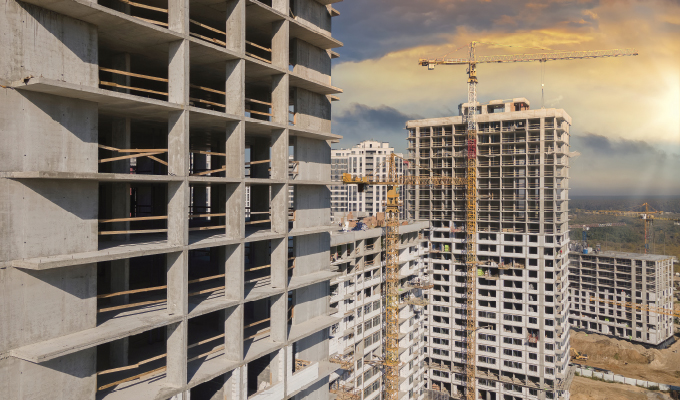It’s not your father’s (or mother’s) office anymore. While early adopters were already integrating new technologies to transform the traditional workplace setting, the evolution of the modern office was put into hyperdrive by the unexpected catalyst of a worldwide pandemic.
Today, building owners, operators, and developers are looking for ways to attract and retain tenants. Expectations for new work environments are shifting from being strictly about productivity and practicality, to places that promote sustainability, community, experience, collaboration, and creativity.
Technology is the common denominator. Technology has become essential not only to business operations but to the success of most real estate endeavors.
From the digital workplace to health and wellness initiatives, businesses today face market demands to provide modern and engaging experiences for employees while also addressing calls for more sustainability. The following explores the transformative role of technology in the built environment and its impact on real estate strategies and positioning to align office features with tenant needs.
FUTURE-PROOFING TECH
Compared to other elements in the built environment, technology has a relatively short lifespan. Active electronics and equipment supporting a building’s operational technology infrastructure (e.g., switches, servers, and edge devices) typically have a lifecycle of 3-5 years. While certain technology infrastructure within buildings such as the structured cabling plant may last 10-15 years, outliving most network components. This is still significantly much less than the traditional mechanical, electrical, and plumbing (MEP) systems that run for an average of 30 years.
With MEP and technology expenses accounting for a significant portion of overall project costs, it is crucial to understand the full lifecycle of technology equipment and be aware of industry trends driving demands for newer technologies. As seen over the last decade, technology is changing rapidly, and owners must have the foresight to avoid near-term obsolescence of their infrastructure. It is vital to vet technology components, systems, and solutions early in the design and construction process to ensure long-term flexibility and adaptability.
FIVE FACTORS TO CONSIDER WHEN EVALUATING BUILDING/TENANT FIT
When developing real estate strategies, consider the following factors:
Health, Wellness, and Environmental Stewardship: Buildings are currently responsible for almost 40% of global energy related carbon emissions, 28% of which coming from operational emissions and the energy needed to heat, cool, and power them. MEP systems are crucial components in achieving sustainability goals and play a significant role in decarbonization and mitigation strategies.
With environmental, social, and governance (ESG) initiatives becoming front and center of the built environment sector, the demand for improved monitoring, greater transparency, and more conscientious reporting strategies of real estate properties, energy performance will continue to rise and technology solutions will serve as the major enabler in monitoring, tracking, and helping achieve these goals.
Advanced building automation, enabled by smart building platforms, and artificial intelligence allow for real-time data analysis, improved energy efficiency, and greater transparency into building operations.
Intelligent Building Platforms: Technology plays a vital and centric role in the creation and operation of smart buildings. Smart buildings are structures that are equipped with advanced systems that enable them to connect all the building’s various physical devices, operational technologies (OT), and siloed systems, including heating, ventilation, and air conditioning (HVAC), power, energy monitoring, metering, lighting, fire alarm, irrigation, vertical transportation, access control, video surveillance, occupancy, and more, allowing these systems to work together to optimize comfort and safety for occupants.
When evaluating properties, it is important to identify current solutions and the building’s connectivity framework as well as the property owner’s readiness to develop and deploy a smart building strategy that will help enhance building operation, occupant engagement, and experiences within the building.
One of the key technologies that makes smart buildings possible is the Internet of Things (IoT). IoT devices, such as sensors and actuators, can be embedded throughout the building, collecting data on things like temperature, occupancy, and energy usage. This data is then analyzed by software systems to automatically adjust building functions as needed. For example, if a room is unoccupied, the lights and heating may be turned off to save energy.
Another important element in smart buildings is the Building Automation System (BAS). These systems allow building managers to remotely monitor and control fundamental building HVAC functions and are also able to provide some insights into the building’s energy usage which can be used to identify areas where energy efficiency can be improved.
Through interconnectivity, interoperability, and artificial intelligence (AI)-driven solutions, owners, operators, and occupants will benefit from proactive optimization of space, systems, and services helping improve decision-making and overall experiences.
Single Source of Truth: In recent years, BAS solutions have been filling the need for an intelligent building platform by integrating the extensive list of disparate building operational technology (OT) systems and devices to allow for seamless communication and data exchange between all elements.
However, the rapid growth of not only IoT sensors but also software applications from an expansive list of vendors focusing on emerging use cases and experience-based outcomes is creating a massive amount of non-standardized building data. Leading to a slightly different version of our initial problem, as not every device or application are able to speak the same language as BAS communication protocols standards such as ModBus or BACnet. To escape from potential vendor lock-in and allow for interoperability across building systems a different framework and approach is required to help streamline communications and data exchange.
A key element that will lay the foundation of future-proofing buildings, enable scalability of smart technologies, and support the successful deployments of intelligent building platforms is the Independent Data Layer (IDL). The concept of the IDL is to unify all building data and make it available to all devices, applications, and systems via a standardized, open interface without dependence on any one system or restriction to any application regardless of manufacturer or vendor.
To ensure all relevant building data is useful and truly interoperable between devices, systems, and solutions, data needs to be normalized, modeled, labeled, tagged, and have mapped relationships between entities and elements—so that applications accessing the data see it as one uniform model, no matter where the data comes from, creating a true single source of truth for all building systems.
Infrastructure and Connectivity Readiness: Digital strategies and a successful smart building vision rely on robust infrastructure. Assessing a building’s digital capabilities, infrastructure, and connectivity is crucial to ensuring business continuity and ability to support future technologies. Evaluating building infrastructure, capacity, diversity, resilience, communications backbone, risers’ topology, equipment supporting rooms, and infrastructure management policies are some of the key factors in determining a property’s current digital resiliency, future readiness, and long-term viability.
Mobility: Reliable connectivity throughout the property is essential for business continuity and user experience. As society embraces a mobile-first position, evaluating the building’s cellular connectivity infrastructure and planning for future wireless technologies like WiFi6 and WiFi6E becomes crucial. In addition, collaboration with building owners and landlords to establish wireless policies and resolving neighboring space and floor interferences is essential to help ensure an optimal performance for all occupants.
Safety and Security: As buildings become more connected, and smart devices, infrastructure, and systems continue to grow and become an essential part of building functions these systems will also introduce new vulnerabilities and present a tempting target for malicious hackers. The frequency, nature, and sophistication of cyberattacks targeting these systems will also evolve.
With the convergence of information technology (IT) and OT, developing a comprehensive cybersecurity strategy for real estate portfolio and individual properties to protect base building systems and facility networks is essential not only to building operations and the owners’ reputation but the safety and security of its occupants as well.
CLOSING THOUGHT
Technology’s influence on the built environment is undeniable and ensuring the right digital strategy, innovative technologies and infrastructure are in place is essential to helping owners and operators future-proof their real estate strategies and staying ahead in a rapidly evolving landscape.
For building owners, operators, and managers to prosper, their facilities must grow and evolve with new expectations. It is no longer adequate to provide four walls, a ceiling, and a floor for a basic office. These spaces must now also demonstrate an environment of health, safety, efficiency, and sustainability with positive interactions and social support.

About the Author:
Mo Fahim is the intelligent building technology practice leader for ESD, a leading global engineering firm specializing in mechanical, electrical, plumbing, fire protection, life safety, structural, and technology engineering. He is focused on the exciting, uncharted waters of digital transformation within the built environment. For more, visit www.esdglobal.com.
Modern Contractor Solutions, October 2023
Did you enjoy this article?
Subscribe to the FREE Digital Edition of Modern Contractor Solutions magazine.



